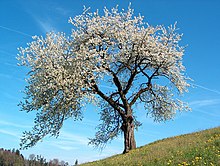Amygdalus
| Prunus | |
|---|---|
 |
|
| Prunus cerasus (sour cherry) in bloom | |
| Scientific classification | |
| Kingdom: | Plantae |
| (unranked): | Angiosperms |
| (unranked): | Eudicots |
| (unranked): | Rosids |
| Order: | Rosales |
| Family: | Rosaceae |
| Subfamily: | Amygdaloideae |
| Genus: |
Prunus L. |
| Species | |
|
see text |
|
| Synonyms | |
|
|
see text
Prunus is a genus of trees and shrubs, which includes the plums, cherries, peaches, nectarines, apricots and almonds.
Around 430 species are spread throughout the northern temperate regions of the globe. Many members of the genus are widely cultivated for fruit and ornament. The fruit from this genus are commonly called the stone fruit.
Members of the genus can be deciduous or evergreen. A few species have spiny stems. The leaves are simple, alternate, usually lanceolate, unlobed, and often with nectaries on the leaf stalk. The flowers are usually white to pink, sometimes red, with five petals and five sepals. There are numerous stamens. Flowers are borne singly, or in umbels of two to six or sometimes more on racemes. The fruit is a fleshy drupe (a "prune") with a single relatively large, hard-coated seed (a "stone").
Within the rose family Rosaceae, it was traditionally placed as a subfamily, the Amygdaloideae (incorrectly "Prunoideae"), but was sometimes placed in its own family, the Prunaceae (or Amygdalaceae). More recently, it has become apparent that Prunus evolved from within a much larger clade now called subfamily Amygdaloideae (incorrectly "Spiraeoideae").
In 1737, Carl Linnaeus used four genera to include the species of modern Prunus—Amygdalus, Cerasus, Prunus and Padus—but simplified it to Amygdalus and Prunus in 1758. Since then, the various genera of Linnaeus and others have become subgenera and sections, as it is clearer that all the species are more closely related. Liberty Hyde Bailey says:
...
Wikipedia
